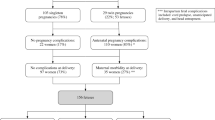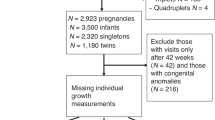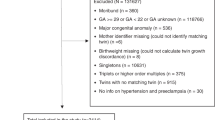Abstract
OBJECTIVE:
To determine whether one structurally affected fetus of a twin pregnancy further increases the risk of preterm delivery and to compare perinatal morbidity and mortality in these pregnancies with twin gestations with structurally normal fetuses.
STUDY DESIGN:
The cases (n = 25) included all twin gestations diagnosed from 1991 to 1994 with a sonographically detected fetal anomaly and a structurally normal co-twin delivered after 24 completed weeks’ gestation. The control group consisted of 547 twin gestations delivered during the study period with no sonographically detected structural anomalies in either twin.
RESULTS:
Compared with controls, pregnancies with a single anomalous fetus (cases) delivered at a significantly lower gestational age (mean ± SD: 34.0 ± 3.2 weeks versus 35.6 ± 3.2 weeks; p = 0.019) and had a significantly increased preterm delivery rate (76.0% vs 55.4%; p = 0.042). There was no significant difference in the incidence of intraventricular hemorrhage or respiratory distress syndrome, yet the perinatal mortality (80.0/1000 vs 6.4/1000; p = 0.000) and the average nursery stay (45.5 ± 43.3 days versus 17.0 ± 24.0 days; p = 0.003) were significantly increased for cases compared with controls. In addition, a significantly greater birth weight discordancy (≥30%) was seen in cases compared with controls (32.0% versus 9.1%; p = 0.002). The normal co-twin did not show any significant difference in the perinatal outcome variables studied when compared with controls.
CONCLUSION: Compared with structurally normal twin pairs, twin gestations with a single anomalous fetus are at a significantly increased risk for preterm delivery. In addition, the anomalous fetus, but not the structurally normal co-twin, has a significantly increased mortality rate and a longer nursery stay. Finally, despite the increased risk for preterm delivery in twin pregnancies with one anomalous fetus, it is the nature of the anomaly itself that dictates the perinatal outcome.
This is a preview of subscription content, access via your institution
Access options
Subscribe to this journal
Receive 12 print issues and online access
$259.00 per year
only $21.58 per issue
Buy this article
- Purchase on SpringerLink
- Instant access to full article PDF
Prices may be subject to local taxes which are calculated during checkout
Similar content being viewed by others
Author information
Authors and Affiliations
Corresponding author
Rights and permissions
About this article
Cite this article
Nassar, A., Adra, A., Gómez-Marín, O. et al. Perinatal Outcome of Twin Pregnancies With One Structurally Affected Fetus: A Case-Control Study. J Perinatol 20, 82–86 (2000). https://doi.org/10.1038/sj.jp.7200318
Published:
Issue date:
DOI: https://doi.org/10.1038/sj.jp.7200318



